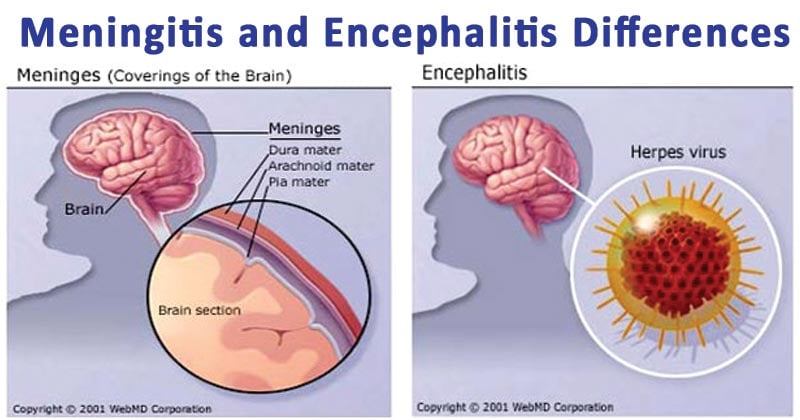Interesting Science Videos
Differences between Meningitis and Encephalitis

Meningitis and Encephalitis are the two main kinds of neurological conditions related to the brain and spinal cord, where the layer surrounding the brain or the brain itself gets inflamed.
S.N. |
Character |
Meningitis |
Encephalitis |
| 1. | Definition | Inflammation of the thin membranes that surround the brain and spinal cord called the meninges (mostly of the pia mater and arachnoid mater). | Inflammation of the brain parenchyma. |
| 2. | Causative Agent | Bacteria, Viruses and Fungi | Mostly Viruses |
| 3. | Microorganisms involved | The most common are echovirus, poliovirus, and coxsackie.
Bacterial meningitis develops under the action of Streptococcus, Neisseria, Haemophilus, Listeria, and other bacteria. |
Viruses (herpes virus, rabies virus, arboreal viruses, cytomegalovirus, etc.);
Bacteria – often occurring as meningoencephalitis caused by meningococci, pneumococci, Hemophilus, tuberculous bacteria, etc.) Fungi or parasites such as leptospirosis, toxoplasmosis, trichinellosis, etc. |
| 4. | Other Causes | o Response to a brain tumor;
o Reaction after a chemotherapy; o Poisoning with lead; o Reaction after complex studies with a contrast medium; o Parasites, fungal infections. |
o Complicated brain tumors;
o Sarcoidosis; o Leukemia; o Multiple sclerosis; o Lead poisoning; o Reaction after application of various substances in the liquor; o Cerebrovascular accidents, etc. |
| 5. | Incubation period | The symptoms of meningitis develop within a few hours to a couple of days. | The most common incubation period is 3-5 days. |
| 6. | Symptoms | Headache is most common, along with vomiting or nausea, skin rash or discoloration of skin, high fever, stiff neck, confusion, double vision. | Headache, joint pain, irritability, fever, lethargy, seizures, behavioral changes. |
| 7. | Complications | o Temporary or permanent loss of hearing or vision;
o Irreversible brain damage, affecting the cognitive abilities, movement abilities o Hydrocephalus; o Encephalitis. |
o Memory problems
o Personality and behavioral changes o Speech problems o Epilepsy o Physical and motor difficulties o Low mood o Fatigue |
| 8. | Rash | Skin discoloration or rash may be present | Absent |
| 9. | Altered Mental Status | No focal deficits or AMS | Altered Mental Status |
| 10. | Forms | Meningitis can be only of one form. | Primary and secondary encephalitis.
o Primary: the brain and spinal cord are directly affected. o Secondary: the infection enters the brain after affecting another organ. |
| 11. | Types | o Tuberculous meningitis,
o Aseptic meningitis o Syphilitic aseptic meningitis o Cryptococcal meningitis o Staphylococcal meningitis o Gram negative meningitis o Pneumococcal meningitis o H.influenza meningitis Meningococcal meningitis. |
o Polyoencephalitis – localized in the gray matter of the brain/spinal cord;
o Leucoencephalitis – localized in the cerebral white brain matter; o Panencephalomyelitis – localized in the gray and white matter of the brain/spinal cord; o Perivenous encephalomyelitis. |
| 12. | Modes of Transmission
(Transmission possibility depends on the type of causative agent involved) |
Bacteria are present in discharges from the nose and mouth and cause transmission through droplets. | o Breathing in respiratory droplets from an infected person
o Skin contact o Mosquito, tick, and other insect bites o Tick of Horses o Migratory Birds o Contaminated food or drink |
| 13. | Risk group age | Those older than 60 and younger than 5 are at highest risk. | Occurs most frequently in infants younger than 1 year of age and in elderly patients older than the age of 65 with intermediate incidence in individuals between these age extremes. |
| 14. | Diagnosis | Physical examination,
Followed by CBC with differential, C-reactive protein, and blood for Gram stain and culture. |
Clinical presentation and supported by spinal fluid analysis and neuroimaging abnormalities, CSF, PCR. |
| 15. | CSF findings | The cerebrospinal fluid (CSF) is abnormal. | The CSF findings are variable. |
| 16. | Treatment | Ampicillin is usually prescribed along with an aminoglycoside or a cephalosporin (cefotaxime) medication. | Acyclovir, and is usually administered intravenously in the hospital for at least ten days. |
| 17. | Vaccines | Vaccines of varying effectiveness exist against the following bacterial causes of meningitis:
o Streptococcus pneumoniae; o Neisseria meningitides; o Mycobacterium tuberculosis. |
Vaccines exist against some types of encephalitis:
o Tick-borne encephalitis vaccine; o Japanese encephalitis vaccine. |
References
- https://microbiologyinfo.com/difference-between-meningitis-and-encephalitis/
- http://www.differencebetween.net/science/difference-between-meningitis-and-encephalitis/
- https://www.empowher.com/aseptic-meningitis/content/difference-between-meningitis-and-encephalitis?page=0,1
- Infectious Diseases Society of America: www.idsociety.org.
- https://www.sciencedirect.com/topics/neuroscience/meningitis
- https://www.sciencedirect.com/topics/neuroscience/encephalitis
